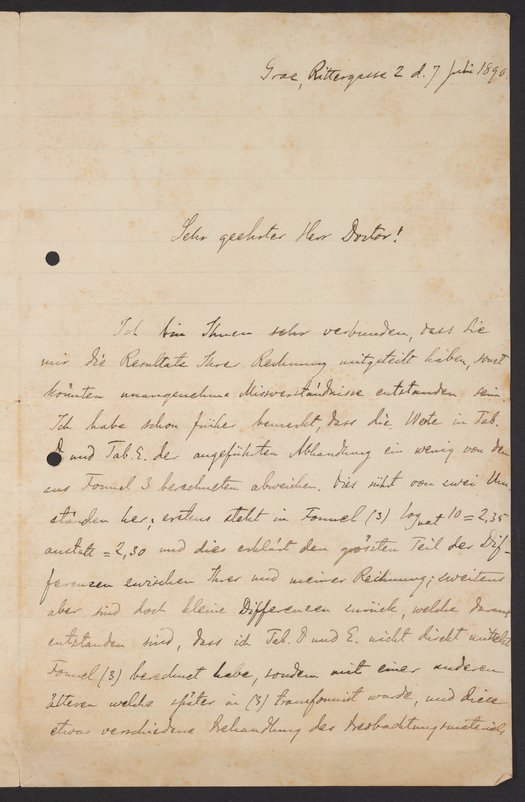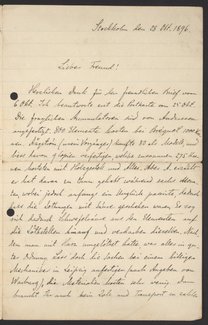Letter from Svante Arrhenius to Georg Bredig, July 1890
- 1890-Jul-02

Rights
Download all 3 images
PDFZIPof full-sized JPGsDownload selected image
Small JPG1200 x 1832px — 312 KBLarge JPG2880 x 4397px — 1.6 MBFull-sized JPG3706 x 5658px — 2.6 MBOriginal fileTIFF — 3706 x 5658px — 60.0 MBSvante Arrhenius (1859-1927), a Swedish chemist and the Nobel Prize Winner for Chemistry in 1903, explains to his friend and colleague Georg Bredig (1868-1944) his method for obtaining mathematical calculations for an experiment, which were very similar to Bredig's results. Arrhenius additionally mentions that he would be glad to discuss the calculations with Bredig in person when he visits Leipzig.
| Property | Value |
|---|---|
| Addressee | |
| Author | |
| Place of creation | |
| Format | |
| Genre | |
| Extent |
|
| Language | |
| Subject | |
| Rights | No Copyright - United States |
| Credit line |
|
| Additional credit |
|
| Digitization funder |
|
Institutional location
| Department | |
|---|---|
| Collection | |
| Series arrangement |
|
| Physical container |
|
View collection guide View in library catalog
Learn More
Related Items
Cite as
Arrhenius, Svante. “Letter from Svante Arrhenius to Georg Bredig, July 1890,” July 2, 1890. Papers of Georg and Max Bredig, Box 1, Folder 4. Science History Institute. Philadelphia. https://digital.sciencehistory.org/works/ulkmpwv.
This citation is automatically generated and may contain errors.
Image 1
Graz, Rittergasse 2 d. 7 Juli 1890
Sehr geehrter Herr Doctor!
Ich bin Ihnen sehr verbunden, dass Sie mir die Resultate Ihrer Rechnung mitgeteilt haben, sonst könnten unangenehme Missverständnisse entstanden sein. Ich habe schon früher bemerkt, dass Sie Werte in Tab. D und Tab. E der angeführten Abhandlung ein wenig von den aus Formel 3 berechneten abweichen. Dies ruht von zwei Umständen her; erstens steht in Formel (3) lognat 10 = 2,35 anstatt = 2,30 und dies erklärt den grössten Teil der Differenzen zwischen Ihrer und meiner Rechnung; zweitens aber sind doch kleine Differenzen zurück, welche daraus entstanden sind, dass ich Tab. D und E. nicht direkt mittelst Formel (3) berechnet habe, sondern mit einer anderen älteren welche später in (3) transformiert wurde, und diese etwas verschiedene Behandlung des Beobachtungsunterschiedes
Image 2
(page 2)
erklärt die noch vorhandenen kleinen Differenzen. Ich gebe zu es wäre wichtiger gewesen (wegen der Gleichmässigkeit) die Ziffern mit Formel (3) umzurechnen (2,35 korrigiert zu 2,30). Ich habe aber damals davon Abstand genommen, da die Differenzen zwischen den beiden Berechnungsweisen relativ unbedeutend sind und jedenfalls ohne irgend einer praktischen Bedeutung. Es können nämlich die W35 für die stark dissoziierten Körper in kleiner Weise eine Richtigkeit von 110 cal. beanspruchen, wie ich auch direkt (p. 106 2.8 v.k.) bemerkt habe. Das richtigste wäre also gewesen nicht nur die letzte, sondern auch die vorletzte Ziffer im Werte von W35 zu unterschieden. Da ich jedoch Schuld bin zu diesem Missverständnis, habe ich die W35 in Tab. E und die berichtigten Formel (3) (vgl. Zeitschrift für physikalische Chemie. V, 3 Note) umgerechnet und habe ich folgende Werte bekommen:
(mathematical formula)
Ich wiederhole aber, dass die zwei letzten Ziffer ohne jeder
(page 3)
Bedeutung sind. Ausserdem kann man aus den als sehr gut ausgesehenen Ziffern von Kohlrausch W22 berechnen indem K. seine Messung bei 18° und 26° C angestellt hat (für 0,01 normale Lösung).
Was Ihre Berechnungen betrifft, so sind dieselben ganz richtig, wenn anstatt 2,35 2,30 eingeführt wird.
Falls Sie weitere Aufklärungen wünschen, bin ich ausserordentlich erfreut Ihren Wünschen entgegenzukommen. Ich werde in etwa 3 Wochen mich ein paar Tage in Leipzig aufhalten, und ist dann gute Gelegenheit die Sache näher zu besprechen.
Mit bestem Gruss
Ihr ergebener
Svante Arrhenius
Image 1
Graz, Rittergasse 2, July 7, 1890
Dear Dr. Bredig,
Thank you very much for letting me know the results of your calculations. Otherwise, unpleasant misunderstandings could have arisen. I have noticed before that the values in Table D and Table E of the paper cited, differ somewhat from those calculated from Formula 3. This is due to two circumstances. First, it states lognat 10 = 2.35 in formula (3) instead of = 2.30 and this explains most of the differences between your calculation and mine. Secondly, however, there are minor differences, which arose from the fact that I did not calculate Tables D and E directly using formula (3), but with another, older one which was later transformed into (3). This somewhat different approach in observation
Image 2
(page 2)
explains the small discrepancies that still exist. I admit it would have been more important (for the sake of uniformity) to convert the numbers with formula (3) (2.35 corrected to 2.30). At the time, however, I refrained from doing so, since the differences between the two calculation methods are relatively insignificant and without any practical implications anyhow. W35 can claim an accuracy of 110 cal. for the strongly dissociated bodies, as I also observed directly (p. 106 2.8 v.k.). It would have been most accurate to differentiate not only the last number, but also the next to last number in the value of W35. However, since I am to blame for this misunderstanding, I converted W35 in Table E and the corrected formula (3) (see the Journal for Physical Chemistry, V, 3rd footnote) and obtained at the following values:
(mathematical formula)
I repeat, however, that the last two numbers
(page 3)
are meaningless. In addition, you can calculate W22 from Kohlrausch’s figures, which looked very good, since Kohlrausch obtained his measurement at 18° and 26° C (for 0.01 normal solution).
As for your calculations, they are quite correct if 2.30 is applied instead of 2.35.
If you would like further clarification, I would be very glad to help you. In about three weeks, I will be in Leipzig for a few days and that would be a convenient time to discuss the matter in more detail.
Best wishes.
Sincerely,
Svante Arrhenius







